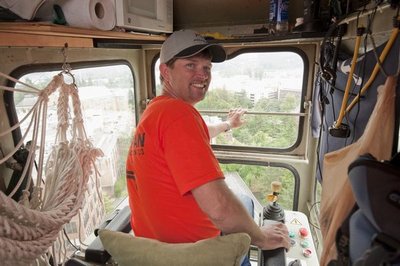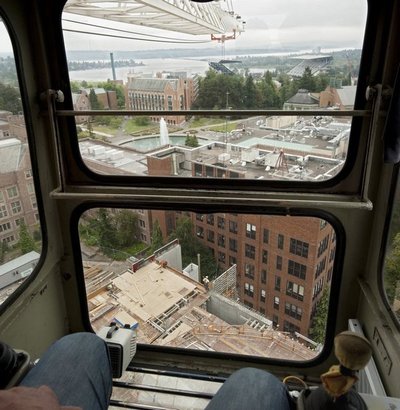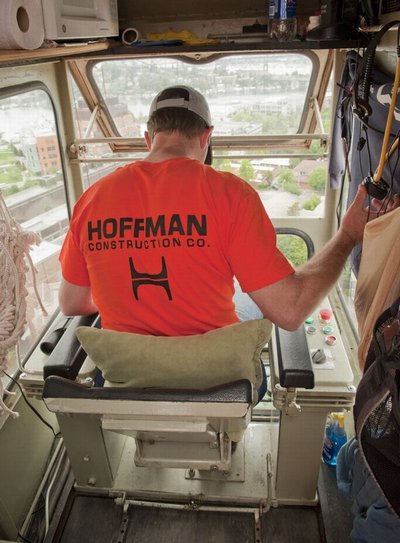August 19, 2010
An office in the sky: Crane operator too busy to appreciate the scenery 180 feet up
Imagine going from job to job, yet always having an office with a view. Of course, you’ll have to climb to your office on ladder rungs that resemble a fire escape, and once in it, you won’t leave it all day. And most of the time, you’ll be intent enough on your work that you won’t notice the view.
Welcome to the world of the tower crane operator. Your “office” is a cab that’s crowded if two people are in it. You sit in a chair flanked by two consoles containing all the crane’s controls and you spend the day moving things from one place to another.
“It [the crane] picks up almost everything you put into that building,” said crane operator Tyke Melhart. “Whether it be an iron job or a concrete job like this one, the tower crane is involved.”
Melhart is working on the Molecular Engineering Building, across Stevens Way from the Architecture Building. It’s the third building on the UW campus that he’s worked on. He’s an employee of Garner Construction, which is a subcontractor for Hoffman Construction, the company in charge of this job.
Tower cranes are so called because the cab is mounted on a tower so the machine is stationary; only the jib moves. They’re typically used for very tall buildings or for sites where there is little room to maneuver.
The Molecular Engineering Building site falls into the latter category. The building isn’t that tall, but with all the surrounding buildings, a mobile crane wouldn’t have enough room to move. Melhart’s cab is 180 feet off the ground, high enough to give some people the hebeegebees, but it’s nothing compared to the 560 foot crane he once worked in for a high-rise project. Of course, Melhart jumped out of airplanes when he was in the Marine Corps, so he has no problem with heights.
“I grew up on a 200-acre farm, so I’ve been around heavy equipment pretty much all my life,” he said. “After the military, I got into construction, running equipment like backhoes and dozers.”
Then, Melhart began working on a construction project where there was a tower crane, and it was love at first sight. Two weeks later he was asking his boss, “How do I get into one of those?”
These days, operating a tower crane requires formal training, but back then it was strictly on the job. Melhart practiced running the crane after work, and then worked as a bellman before getting his chance as crane operator. A bellman is the person on the ground who guides the crane operator when he’s “in the blind” — that is, when he can’t see the load he’s picking up or placing.
“He talks to me over the radio and tells me everything I need to know,” Melhart said. “When I swing the hook around I’ll bring it down to him and he’ll grab the hook. He makes sure that the load is properly rigged — that the straps go around and everything is secure on the load. He’ll say, ‘Up easy,’ then, ‘Getting tight,’ which means that the straps around the load are getting tight so there’s not a big jerk when you pull up the load. From there it’s just, ‘Coming up.’ Then he looks up, makes sure everything’s clear and it’s, ‘Up up.’ Then I take the load to the next point of where it’s going to go.”
The whole process is reversed as he’s putting the load down.
“You really have to trust your bellman,” Melhart said. “On this job, Hoffman and the University have made the job safer, more expedient and less stressful for all involved by using two bellmen to ensure proper catching and releasing of loads.”
Inside the cab, running the crane is all about the hands — the hoist (up and down) is in the right hand, the swing (lateral moves) and moving the hook on the trolley is in the left. There’s a gear shift that looks much like the one in a car, permitting the operator to control how fast he moves a load. The operator has a panoramic view on three sides of where he’s sitting, but most of the time his eyes are trained on the building being constructed, not on the distant water or mountains.
Cramped as his quarters are, a crane operator is not going to climb up and down 180 feet or more to take a break, so how does he, um, take care of necessities? “I have a two and a half gallon gas can with a hose that goes down to a Sani-Can,” Melhart said, answering the first question he says is on everyone’s mind when they find out he stays in the cab all day. The second may well be about air conditioning, which this particular crane has but which many in this region do not.
In 12 years of operating tower cranes, Melhart said, he’s never been involved in a major incident, but he did have a “wild ride” once. That was on Feb. 28, 2001, when he was working on a 12-story building in Pioneer Square and the Nisqually earthquake struck. But he said he felt safer in the crane than he would have on the ground.
“I was watching people running around and bricks falling off buildings and onto cars. It was crazy.”
Some people would say running cranes for a living is crazy, but Melhart finds it satisfying. “When you walk away from a finished building, you pretty much know you had a part in everything,” he said. “It’s pretty cool that you can come back and say, ‘I did that.'”



